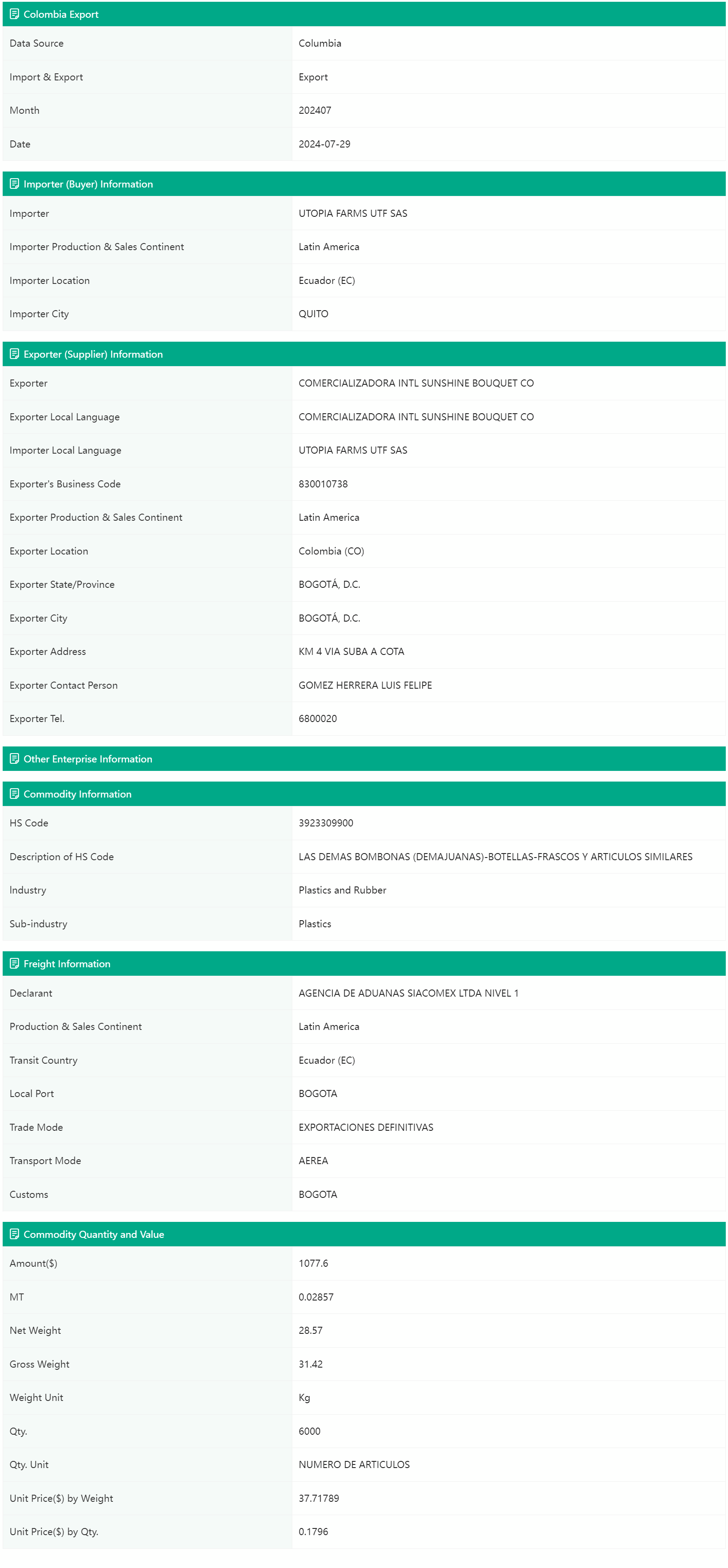Colombia is located in the northwestern part of South America. It is bordered by Venezuela and Brazil to the east, Ecuador and Peru to the south, Panama to the northwest, the Caribbean Sea to the north, and the Pacific Ocean to the west. As the gateway for land transport across South America, Colombia is the only country in the region with coastlines on both the Atlantic and Pacific Oceans.
Colombia has well-established industries in textiles, chemicals, leather processing, food production, paper manufacturing, metallurgy, and machinery production, making it the most industrially developed country in the Andean region. Its agricultural production is known for coffee, flowers, and bananas.
The country has eight major language groups, with Spanish as the official language. Most middle- to upper-level professionals can also communicate in English.
**Coffee Industry**
Colombia is a leading producer of high-quality Arabica coffee and ranks as the third-largest coffee producer and exporter globally, behind Brazil and Vietnam. It is also the world’s largest exporter of Arabica beans.
In the 2022 coffee season (October–December), Colombia's coffee production reached 2.9 million bags, a 17% year-on-year decline. Coffee exports during this period amounted to 2.827 million bags, down 14% from the previous year. Coffee exports accounted for 19% of the total non-mineral energy exports, with key export destinations including the United States, Canada, Belgium, and Japan. Major coffee processors and exporters in Colombia include Grupo Nutresa, Racafé & Cía, and Cafetera La Meseta.
In August 2024, Colombia exported 1 million bags of coffee, marking a 25% year-on-year increase. For the period from January to August 2024, coffee exports reached 7.77 million bags, up 17% compared to the same period the previous year.
**Flower Industry**
Colombia is the second-largest flower exporter in the world after the Netherlands, with nearly all production dedicated to export. According to data from the Colombian National Administrative Department of Statistics and ProColombia, flower exports reached 240 million tons in 2022, a 9% increase year-on-year, with an export value of $2.03 billion, up 19.1%. The main export markets for Colombian flowers include the United States, Canada, the UK, Japan, and the Netherlands. Leading flower processing and export companies include Sunshine Bouquet, Flores Ipanema, and Jardines Andes.
**Mining Industry**
In 2022, Colombia's mining exports were valued at $22.155 billion, a 65.6% year-on-year increase, accounting for 34% of the country’s total exports. Coal exports reached 60.93 million tons, a 2.2% increase year-on-year, with export revenues of $12.29 billion, up 117.5%. Nickel exports for the first three quarters of 2022 reached 110,000 tons, up 35.8%, with revenues of $744 million, up 94.7%. Gold exports amounted to 23 tons, generating $3.134 billion in revenue. Colombia holds the largest emerald reserves in the world, typically accounting for half of the global market. According to Colombia's National Mining and Energy Planning Unit (UPME), emerald exports for the first three quarters of 2022 totaled $79.79 million, down 2.4% year-on-year. Key oil and gas companies operating in Colombia include Canacol Energy Ltd. (a Canadian oil and gas producer), CEPSA Colombia S.A. (a Canadian crude oil extraction company), Chevron Petroleum Company (a U.S. oil and gas company), and Ecopetrol S.A. (a Colombian oil company).
**Colombia's Foreign Trade in 2022**
In 2022, Colombia's total merchandise trade amounted to $134.323 billion, reflecting a year-on-year growth of 32.6%. Imports reached $77.413 billion, up 26.7%, while exports stood at $56.91 billion, showing a 41.5% increase.
Colombia's main exports consist of extractive products such as crude oil and minerals, along with agricultural products. On the import side, industrial manufactured goods and gasoline are the primary products. In 2022, fuel and extractive products accounted for 56.1% of exports, followed by agricultural products at 20.2% and manufactured goods at 18.4%. For imports, industrial manufactured goods represented 73.9%, agricultural products 14.6%, and extractive products 11.3%.
The United States, China, and Brazil were Colombia's top three trade partners in 2022. The leading sources of imports were the United States ($18.839 billion), China ($18.698 billion), and Brazil ($5.495 billion), accounting for 24.3%, 24.1%, and 7.1% of total imports, respectively. The top export destinations were the United States (25.8%), Panama (10.2%), and the Netherlands (4.7%).
**July 2024 Trade Data**
In July 2024, Colombia's exports amounted to $4.618 billion (FOB), representing a 10.8% increase compared to July 2023. This growth was primarily driven by a 6.3% rise in the export of fuel and extractive products, which accounted for 50.4% of the total FOB export value. Agricultural products, food, and beverages made up 20.5%, manufactured goods accounted for 20.4%, and other industries contributed 8.7%.
In July 2024, Colombia exported 14 million barrels of crude oil, marking a 15.0% decline compared to July 2023.
Colombia's imports in July 2024 reached $5.581 billion (CIF), a 12.9% increase compared to the same month in 2023. This growth was mainly driven by an 18.0% increase in manufactured goods, which made up 78.9% of the total CIF import value. Agricultural products, food, and beverages accounted for 11.5%, fuel and extractive products 9.4%, and other industries 0.2%.
From January to July 2024, Colombia's imports totaled $36.153 billion, down 1.7% year-on-year. Imports from the U.S. accounted for 25.8% of the total, followed by China at 23.5%, Brazil (5.4%), Mexico (5.2%), Germany (3.4%), India (2.4%), and Japan (2.3%). Benefiting from increased computer purchases by Colombia, Chinese exports to Colombia grew by 2.1% year-on-year.
**Blooming Trade Data**
Colombian customs data is regularly updated and includes detailed information on importers, exporters (addresses, phone numbers, etc.), goods, shipping details, and key metrics such as transaction volume, value, and unit price. This helps you stay informed about Colombia's import and export markets with ease.
Are you looking to understand market demand in Colombia? Do you want to expand your international presence there? Are you seeking stronger partnerships with clients and reliable suppliers in Colombia?

Sample Data


